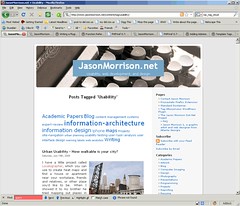 A few months ago I attended a really interesting talk by Eric Meyer where he touched on the use of microformats. You might know Eric from his excellent O’Reilly Press CSS books.
A few months ago I attended a really interesting talk by Eric Meyer where he touched on the use of microformats. You might know Eric from his excellent O’Reilly Press CSS books.
What are microformats? Before giving an example, I’ll give a little context. When Tim Berners-Lee created the web, he tried to make HTML simple, flexible, and meaningful. He succeeded on the first two counts but the third was quickly left by the wayside – many designers didn’t care what a particular tag meant, so long as it could be used for page layout. The use of tables to arrange graphic elements instead of holding tabular data is a perfect example.
So Berners-Lee has been talking for years about the next step – the semantic web. In the semantic web, tags are used to say what a particular piece of content is, with all styling done with stylesheets. There is, of course, more to the semantic web than just separating content and presentation, after all you can work that way with HTML and CSS now. One other key component is the web of trust, where people and web sites are able to describe relationships to each other so that search engines can help you find trustworthy content automatically.
Unfortunately, the semantic web has not really taken off. There have been lots of meetings and XML schemas but it’s all too complicated, the process is too bureaucratic, and everything is being designed from the top down.
This is where microformats come in. Let’s say you have a blog and you’ve tagged all your articles. You’d like to let search engines and aggregators like Technorati know what your tags are. But HTML doesn’t have anything like this:
<tag>semantic web<tag>
So what do you do? Simple, use the rel-tag microformat:
<a href=”http://example.com/tag/semantic+web” rel=”tag”>semantic web</a>
The microformat makes use of existing html tags and attributes and just follows simple conventions. But now that this little bit of meaning can be interpreted by spiders and other programs, we’ve actually added a pretty powerful bit of functionality to the web.
Most blog software, including WordPress, includes does microformatting for you. If install my tag cloud plugin Altocumulous, and view source, you can see for yourself.
For intranet purposes, the hCard and hCalendar microformats look promising. Take a look at microformats.org to see why I think so. I’ll write more on it later.

